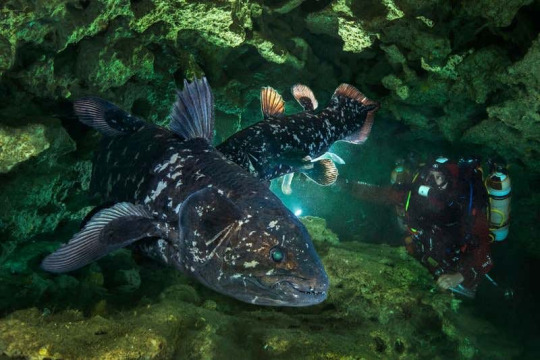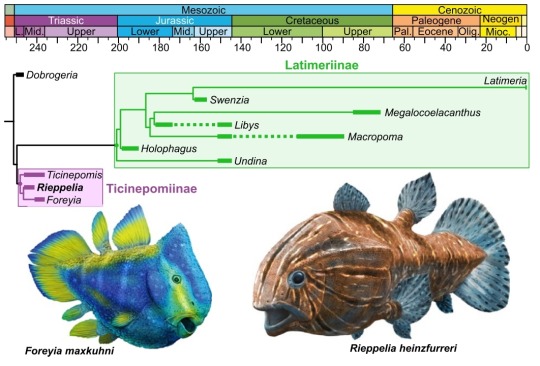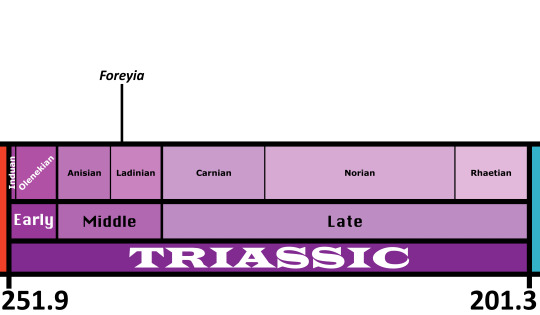#Latimeriidae
Text
Uncharismatic Fact of the Day
Coelacanths are often thought of as a species untouched by time, due to their ancient evolutionary lineage and long lifespans. These fish evolve slow, move slowly, grow slowly, and even give birth slowly; pregnancies can last anywhere from three to five years, after which she gives birth to up to 25 live pups.

(Image: A pair of West Indian Ocean coelacanth (Latimeria chalumnae) (left) by Laurent Ballesta)
If you like what I do, consider leaving a tip or buying me a kofi!
218 notes
·
View notes
Text
Early Mesozoic burst of morphological disparity in the slow-evolving coelacanth fish lineage
Published 13th July 2023
A newly identified species of stem coelacanth, Rieppelia heinzfurreri, based on mid 20th century specimens.

Rieppelia heinzfurreri holotype and skeletal reconstruction

Juvenile or newborn specimen of Rieppelia heinzfurreri

Fossil and illustration of the skeleton of Foreyia maxkuhni, from
Rieppelia heinzfurreri and Foreyia maxkuhni are closely related and share the same family

Time-tree phylogeny of Latimeriidae with reconstructions of Foreyia and Rieppelia, Artwork by Alain Bénéteau.
Source:
113 notes
·
View notes
Text

Rieppelia
Rieppelia — викопний рід лопатеперих риб сучасної родини Латимерієві (Latimeriidae), відомий з середнього тріасу Швейцарії. Типовий і єдиний вид — Rieppelia heinzfurreri.
Повний текст на сайті "Вимерлий світ":
https://extinctworld.in.ua/rieppelia/
#rieppelia#switzerland#triassic#osteichthyes#fish#chordata#ua#paleontology#paleoart#prehistoric#article#palaeoblr#sciart#палеоарт#палеонтологія#ukraine#ukrainian#україна#мова#українська мова#арт#риби#український tumblr#український тамблер#український блог
11 notes
·
View notes
Text
all the v2 descendants name meanings
Babe Coelho: first name, babes in the woods. last name, pablo coelho (i was reading the alchimist at the time)
Beau Coelho: first name has no significance, matches with babe
Josafn Edvard: first name, josephine was a popular name in the 1920s. Last name, edward was a common last name in the 1920s. also edward cullen
Timeri Estexs: first name, laTIMERIidae (gentic order of modern coelacanths). last name, the ghost hunting estes method
Saturn Cariot: first name, planet/roman god. last name, chariot
Elyzia Goesha: first name, elysian. last name, ars goetia
M'lenko Makara: first name, the great milenko album. Last name, you already know this one
#didnt do the candy kids cos their names are pretty obvious#how do yall pronounce their names? im curious#theres one more denscendant that wont be here for a while#homestuck v2#mspfa#babe coelho#beau coelho#josafn edvard#timeri estexs#saturn cariot#elyzia goesha#m'lenko makara
0 notes
Photo

West Indian Ocean coelacanth (Latimeria chalumnae)
Photo by Arne Kuilman
#west indian ocean coelacanth#gombessa#latimeria chalumnae#latimeria#latimeriidae#coelacanthiformes#actinistia#vertebrata#chordata
576 notes
·
View notes
Note
Top 5 animals
This is going to be impossible if I don’t give myself restrictions, because I’ll just start listing every animal to have ever existed and never stop.
So top five extant animals, to the uhhhh... family level? That still might be too narrow. Orders? Nah, I’ll stick to families. I’ll also keep it to vertebrates otherwise I’ll never be able to keep it down to five.
1. Gobiidae: Gobys are perfect animals I don’t know what else to tell you.
2. Cyclopteridae: Lumpsuckers. Also perfect beings.
3. I’m breaking my family rule here to include the entire order of Sygnathiformes: pipefish, seahorses, seamoths... also perfect animals, every single one.
4. Latimeriidae: the living coelacanths. Perfection.
5. Polypteridae: bichirs and reedfish. You ever see those finlets? Perfect.
Oops all fish.
#it’s a trick because I said I was going to keep it to vertebrates#and all vertebrates are fish#it wouldve been all fish no matter what I said
16 notes
·
View notes
Text
Foreyia maxkuhni

Etymology: Forey’s Fish
First Described By: Cavin et al., 2017
Classification: Biota, Archaea, Proteoarchaeota, Asgardarchaeota, Eukaryota, Neokaryota, Scotokaryota, Opimoda, Podiata, Amorphea, Obazoa, Opisthokonta, Holozoa, Filozoa, Choanozoa, Animalia, Eumetazoa, Parahoxozoa, Bilateria, Nephrozoa, Deuterostomia, Chordata, Olfactores, Vertebrata, Craniata, Gnathostomata, Eugnathostomata, Osteichthyes, Sarcopterygii, Actinistia, Coelacanthiformes, Latimerioidei, Latimeriidae,
Time and Place: Foreyia lived about 240.91 million years ago, in the Ladinian of the Middle Triassic

Foreyia is known from the Prosanto Formation of Switzerland

Physical Description: Foreyia was a Coelacanth, a sort of Lobe-Finned Fish once thought to be a unique feature of prehistoric ecologies, and now known to survive in two different species today. This is wild, of course, but Coelacanths were weird in many different ways throughout their prehistoric tenure. Foreyia looked only a little similar to its cousins - it had a huge head compared to other Coelacanths, as well as a beak - something that you really only see in ray-finned fish and tetrapods - an underbite, and a horn on its head. That said, its body looks similar enough to other coelacanths, with dorsal fins and a wide tail fin, and large forelimb fins. However, the large size of its head makes it look like a Coelacanth that had been squished extensively, with the body looking quite short and squished compared to its close relative Ticinepomis. We aren’t sure as to what colors it may have been, but since it lived in a tropical region and may have had a similar niche as a Parrotfish, it is reasonable to suppose it may have been colorful. It was also very small, only around 20 centimeters long.
Diet: Given the beak, it’s likely that Foreyia ate hard food, potentially even similarly to living parrotfish - by chipping off algae covered rocks and reef builders, or potentially eating small shelled animals in the tidal pools.
Behavior: Foreyia’s head was huge, and so that likely impacted its swimming style, though it is unclear how. Modern Coelacanths moving very slowly through the water, moving their fins to help propel through. Since Foreyia reduced the size of its fins to an extent, it’s possible that the tail (which was very large compared to the rest of the body) was more vital in swimming, and the head may have been used to help steer (though this is just a hypothesis). The bony shield may have also been helpful in protecting Foreyia from danger, which makes sense ans many predators were present in its environment. This is at least somewhat supported by its strong clavicle muscles. It probably would have spent a significant amount of time grazing, either on small crunchy invertebrates or algae. Today, Coelacanths don’t seem to shoal much; however, that may not have been the case in the past, so we can’t infer a loner lifestyle for Foreyia.
Ecosystem: Foreyia lived in a coastal shelf environment, specifically in a tidal basin that would often become anoxic as the tide went out during the day, meaning that Foreyia had to move around a lot to avoid suffocation. This environment was probably at least somewhat reef or tidal pool like, with a variety of fish swimming around in the ecosystem. There were many ray-finned fish here, including Peltopleurus, Habrichthys, Archaeosemionotus, Saurichthys, Ctenognathichthys, Besania, Prosanticthys, Eoeugnathus, and Ducanicthys. There was also another Coelacanth, Ticinepornis. As for tetrapods, there was the Pachypleurosaur Neusticosaurus, the Helveticosaurid Eusaurosphargis, and the Tanystropheid Macrocnemus. These reptiles would have been major predators of Foreyia.
Other: Foreyia is so weird in its shape that the original authors proposed it was Heterochronic - ie, different aspects of baby Coelacanth anatomy were retained in order to provide useful adaptations for Foreyia. However, some later researchers have cast doubts on this idea, given that baby Coelacanths don’t… actually seem to resemble Foreyia. Clearly, the jury is still out!
~ By Meig Dickson
Sources Under the Cut
Arratia, G., and A. Herzog. 2007. A New Halecomorph Fish from the Middle Triassic of Switzerland and its Systematic Implications. Journal of Vertebrate Paleontology 27(4):838-849.
Bürgin, T., U. Eichenberger, H. Furrer and K. Tschanz. 1991. Die Prosanto Formation - eine fischreiche Fossil-Lagerstätte in der Mitteltrias der Silvretta-Decke (Kanton Graubünden, Schweiz). Eclogae Geologicae Helvetiae 84:921-990.
Bürgin, T., and A. Herzog. 2002. Die Gattung Ctenognathichthys (Actinopterygii, Perleidformes) aus der Prosanto-Formation (Ladin, Mitteltrias) Graubündens (Schweiz), mit der Beschreibung einer neuen Art, C. hattichi sp. nov. Eclogae Geologicae Helvetiae 95:461-469.
Carroll, R. L., and P. Gaskill. 1985. The nothosaur Pachypleurosaurus and the origin of plesiosaurs. Philosophical Transactions of the Royal Society B 309:343-393.
Cavin, L., H. Furrer, and C. Obrist. 2013. New coelacanth material from the Middle Triassic of eastern Switzerland, and comments on the taxic diversity of actinistans. Swiss Journal of Geosciences 106:161-177.
Cavin, L., B. Mennecart, C. Obrist, L. Costeur, and H. Furrer. 2017. Heterochronic evolution explains novel body shape in a Triassic coelacanth from Switzerland. Scientific Reports 7(13695):1-7.
Ferrante, C., L. Cavin, H. Furrer, R. Martini. 2018. Coelacanths from the Middle Triassic of Switzerland show unusual morphology. Swiss Geoscience Meeting.
Fraser, N., and H. Furrer. 2013. A new species of Macrocnemus from the Middle Triassic of the eastern Swiss Alps. Swiss Journal of Geoscience 106:199-206.
Herzog, A. 2001. Peltoperleidus obristi sp. nov., ein neuer, kleiner Strahlenflosser (Actinopterygii, Perleidiformes) aus der Prosanto-Formation (Mitteltrias) von Graubünden (Schweiz). Eclogae Geologicae Helvetiae 94:495-507.
Herzog, A. 2003. Eine Neubeschreibung der Gattung Eoeugnathus Brough, 1939 (Actinopterygii; Halecomorphi) aus der alpinen Mitteltrais Graubündes (Schweiz). Palaeontologische Zeitschrift 77(1):223-240.
Herzog, A., and T. Bürgin. 2005. A new species of the genus Besania Brough 1939 from the Middle Triassic of Canton Grisons (Switzerland) with a discussion of the phylogenetic status of the taxon. Eclogae Geologicae Helvetiae 98:113-122.
McMenamin, M.A. S. 2018. Coelacanth Vestiges. Deep Time Analysis, Springer Publishing.
Scheyer, T. M., J. M. Neenan, T. Bodogan, H. Furrer, C. Obrist and M. Plamodon. 2017. A new, exceptionally preserved juvenile specimen of Eusaurosphargis dalsassoi (Diapsida) and implications for Mesozoic marine diapsid phylogeny. Scientific Reports 7:4406.
#foreyia#foreyia maxkuhni#coelacanth#Triass March Madness#triassic madness#triassic#prehistoric life#paleontology
294 notes
·
View notes
Photo

COELACANTH PAPER CRAFT
In 1938, a strange fish was discovered in the Indian Ocean, in the southeast part of Africa. It was a coelacanth, which was believed to have been extinct along with the dinosaurs. Since then it became synonymous of living fossil.
DOWNLOAD PDF[80KB]
How to make the coelacanth is here
37 notes
·
View notes